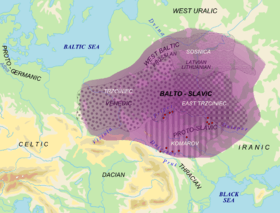Trzciniec culture

The Trzciniec culture is a Bronze-Age archaeological culture in Eastern Europe (c. 1900 – 1200 BC). It is sometimes associated with the Komarov neighbouring culture, as the Trzciniec-Komarov culture. The Trzciniec culture developed from three Corded-Ware-related cultures: Mierzanowicka, Strzyżowska and Iwieńska. These were succeeded by the Lusatian culture, which developed around Łódź.
The areal of the Trzciniec culture corresponds to parts of today's Poland (including Kujawy, Małopolska, Mazowsze, South Podlasie) and western Ukraine. The best known settlements of the Trzciniec culture were in Złota Pińczowskia, Więcławice Świętokrzyskie, Goszyce, and west Bondyrz, close to the kurgans of Guciow. Some of these sites include important treasures containing materials such as ornamental gold and silver like in Stawiszyce and Rawa Mazowiecka.
Inhumation and cremation in a flat grave were important features of Trzciniec culture. Cases of inhumation were discovered in Wolica Nowa, in the form of kurgans. Evidence of kurgan inhumation have been found at Łubna-Jakusy, whereas kurgan cremation has been found at Guciów.
Bibliography
- Prahistoria Ziem Polskich, tom IV pod redakcją W. Hensla Wydawnictwo PAN, Ossolineum, Wrocław, Warszawa, Kraków, Gdańsk, 1979.
- Pradzieje ziem polskich, tom I cz. 2 Epoka Brązu i początki Epoki Żelaza pod redakcją Kmiecińskiego, wyd. PWN Warszawa-Łodź 1989
- Wielka Historia Polski, tom I Najdawniejsze dzieje ziem polskich (do VII w.), Piotr Kaczanowski, Janusz K. Kozłowski, wyd. Fogra Kraków 1998
- Od neolityzacji do początków epoki brązu przemiany kulturowe w międzyrzeczu Odry i Dniepru VI i II tys. przed Chr. – praca zbiorowa pod redakcja Janusza Czebreszuka, Mikoly Kryvalceviča, Przemysława Makarowicza, Uniwersytet im. Adama Mickiewicza w Poznaniu. Instytut Prahistorii. Poznań : Wydaw. Poznańskie, 2001
- Encyklopedia historyczna świata tom I: Prehistoria, praca zbiorowe, opracowanie naukowe prof. Dr hab. Janusz K. Kozłowski, Agencja Publicystyczno-Wydawnicza Oppress, Kraków 1999
- Kultura pradziejowa na ziemiach Polski zarys, Jerzy Gąssowski, PWN, Warszawa 1985